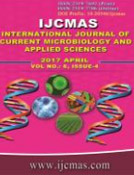


 National Academy of Agricultural Sciences (NAAS)
National Academy of Agricultural Sciences (NAAS)

|
PRINT ISSN : 2319-7692
Online ISSN : 2319-7706 Issues : 12 per year Publisher : Excellent Publishers Email : editorijcmas@gmail.com / submit@ijcmas.com Editor-in-chief: Dr.M.Prakash Index Copernicus ICV 2018: 95.39 NAAS RATING 2020: 5.38 |
Quantitative trait locus (QTL) mapping is a highly effective approach for studying genetically complex forms of plant disease resistance. With QTL mapping, the roles of specific resistance loci can be described, race-specificity of partial resistance genes can be assessed and interactions between resistance genes, plant development and the environment can be analysed (Young, 1996). DNA markers tightly linked to quantitative resistance loci (QRLs) controlling QDR can be used for marker-assisted selection (MAS) to incorporate these valuable traits. QDR confers a reduction, rather than lack, of disease and has diverse biological and molecular bases as revealed by cloning of QRLs and identification of the candidate gene(s) underlying QRLs (Dina St. Clair, 2010). Outstanding examples include: quantitative resistance to the rice blast fungus, late blight of potato, bacterial wilt of tomato, and the soybean cyst nematode. These studies provide insights into the number of quantitative resistance loci involved in complex disease resistance, epistasis and environmental interactions, race-specificity of partial resistance loci, interactions between pathogen biology, plant development. A thorough understanding of quantitative disease resistance (QDR) would contribute to the design and deployment of durably resistant crop cultivars. However, the molecular mechanisms that control QDR remain poorly understood, largely due to the incomplete and inconsistent nature of the resistance phenotype, which is usually conditioned by many loci of small effect (Jesse Poland et al., 2008). QTL mapping methods for complex traits are challenged by new developments in marker technology, phenotyping platforms and breeding methods. Thus QTL mapping approaches will need to also acknowledge the central roles of QTL by environment interactions (QEI) and QTL by trait interactions in the expression of complex traits (Fred van Eeuwijk et al., 2010). DNA marker technology, QTL theory and statistical methodology for QTL analysis have undergone rapid developments in the past two decades. These concepts and the jargon used by molecular biologists may not be clearly understood by plant breeders and other plant scientists (Collard et al., 2005). Host pattern recognition receptor (HPRR) genes, and defense-responsive or defense-related genes are important resources for quantitative broad spectrum resistance and durable resistance (Yanjun Kou and Shiping Wang, 2010). Adaptation to the hypersensitive R-genes by fungal and bacterial specialists is quite different from the adaptations to polygenic quantitative resistance. In first case a loss mutation in the avirulence gene results in restoring the pathogenicity. In the latter, exemplified by the cereals/take-all pathosystem, the mutation is due to a gain mutation. Adaptation by a loss mutation is expected to be much easier than adaptation through a gain mutation. This is the main reason for the large difference in durability (Jan Parlevliet).QRLs for which the phenotypic effects on QDR have been verified and for which tightly linked DNA-based markers have been determined can be (and are) used in marker assisted selection (MAS) breeding strategies for improvement of crop germplasm and development of cultivars.
 |
 |
 |
 |
 |